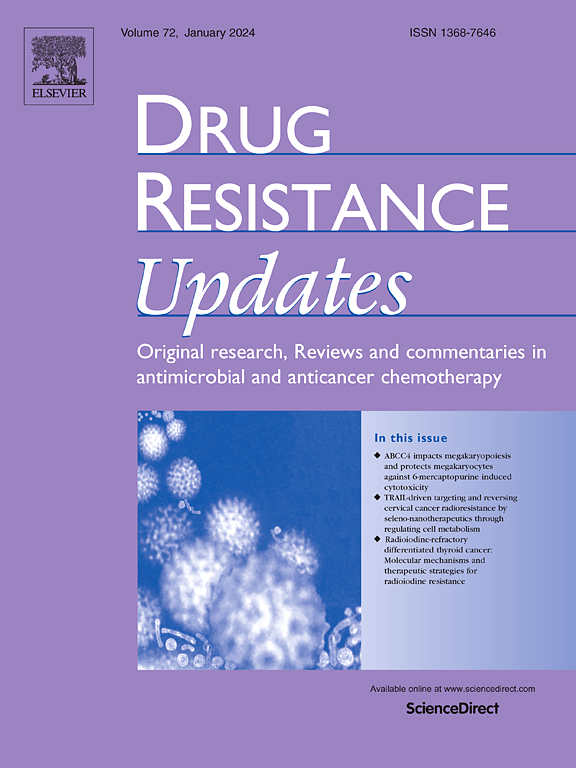5-methylcytosine methylation of MALAT1 promotes resistance to sorafenib in hepatocellular carcinoma through ELAVL1/SLC7A11-mediated ferroptosis
IF 15.8
1区 医学
Q1 PHARMACOLOGY & PHARMACY
引用次数: 0
Abstract
Emerging evidence demonstrates that long non-coding RNAs (lncRNAs) play a crucial role in sorafenib resistance in hepatocellular carcinoma (HCC), and lncRNA metastasis-associated lung adenocarcinoma transcript 1 (MALAT1) is a dysregulated lncRNA in sorafenib-resistant HCC cells. However, the underlying regulatory mechanisms of MALAT1 in sorafenib-resistant HCC cells remain unclear. In the present study, we demonstrated that 5-methylcytosine (m5C) methylation catalyzed by NSUN2 and ALYREF contributed to the RNA stability and upregulation of MALAT1. The NSUN2/ALYREF/MALAT1 signaling axis was activated in sorafenib-resistant cells, and the upregulation of MALAT1 inhibited sorafenib-induced ferroptosis to drive sorafenib resistance. Mechanistically, MALAT1 maintained the mRNA stability of SLC7A11 by directly binding to ELAVL1 and stimulating its cytoplasmic translocation. Furthermore, we explored a new synergetic strategy for the treatment of HCC by combining MALAT1 inhibitor MALAT1-IN1 with sorafenib. The results demonstrated that MALAT1-IN1 significantly enhanced sorafenib efficacy for the treatment of HCC both in vitro and in vivo. Collectively, our work brings new insights into the epigenetic mechanisms of sorafenib resistance and offers an alternative therapeutic strategy targeting ferroptosis for sorafenib-resistant HCC patients.
MALAT1的5-甲基胞嘧啶甲基化通过ELAVL1/ slc7a11介导的铁凋亡促进肝癌患者对索拉非尼的耐药性。
新出现的证据表明,长链非编码rna (lncRNAs)在肝细胞癌(HCC)索拉非尼耐药中起着至关重要的作用,lncRNA转移相关肺腺癌转录物1 (MALAT1)是索拉非尼耐药HCC细胞中失调的lncRNA。然而,MALAT1在索拉非尼耐药HCC细胞中的潜在调控机制尚不清楚。在本研究中,我们证明了NSUN2和ALYREF催化的5-甲基胞嘧啶(m5C)甲基化有助于RNA稳定和MALAT1的上调。在索拉非尼耐药细胞中,NSUN2/ALYREF/MALAT1信号轴被激活,MALAT1的上调抑制索拉非尼诱导的铁凋亡,从而驱动索拉非尼耐药。在机制上,MALAT1通过直接结合ELAVL1并刺激其细胞质易位来维持SLC7A11 mRNA的稳定性。此外,我们探索了MALAT1抑制剂MALAT1- in1与索拉非尼联合治疗HCC的新协同策略。结果表明,MALAT1-IN1在体内和体外均能显著增强索拉非尼治疗HCC的疗效。总的来说,我们的工作为索拉非尼耐药的表观遗传机制带来了新的见解,并为索拉非尼耐药HCC患者提供了一种针对铁下垂的替代治疗策略。
本文章由计算机程序翻译,如有差异,请以英文原文为准。
求助全文
约1分钟内获得全文
求助全文
来源期刊

Drug Resistance Updates
医学-药学
CiteScore
26.20
自引率
11.90%
发文量
32
审稿时长
29 days
期刊介绍:
Drug Resistance Updates serves as a platform for publishing original research, commentary, and expert reviews on significant advancements in drug resistance related to infectious diseases and cancer. It encompasses diverse disciplines such as molecular biology, biochemistry, cell biology, pharmacology, microbiology, preclinical therapeutics, oncology, and clinical medicine. The journal addresses both basic research and clinical aspects of drug resistance, providing insights into novel drugs and strategies to overcome resistance. Original research articles are welcomed, and review articles are authored by leaders in the field by invitation.
Articles are written by leaders in the field, in response to an invitation from the Editors, and are peer-reviewed prior to publication. Articles are clear, readable, and up-to-date, suitable for a multidisciplinary readership and include schematic diagrams and other illustrations conveying the major points of the article. The goal is to highlight recent areas of growth and put them in perspective.
*Expert reviews in clinical and basic drug resistance research in oncology and infectious disease
*Describes emerging technologies and therapies, particularly those that overcome drug resistance
*Emphasises common themes in microbial and cancer research
 求助内容:
求助内容: 应助结果提醒方式:
应助结果提醒方式:


